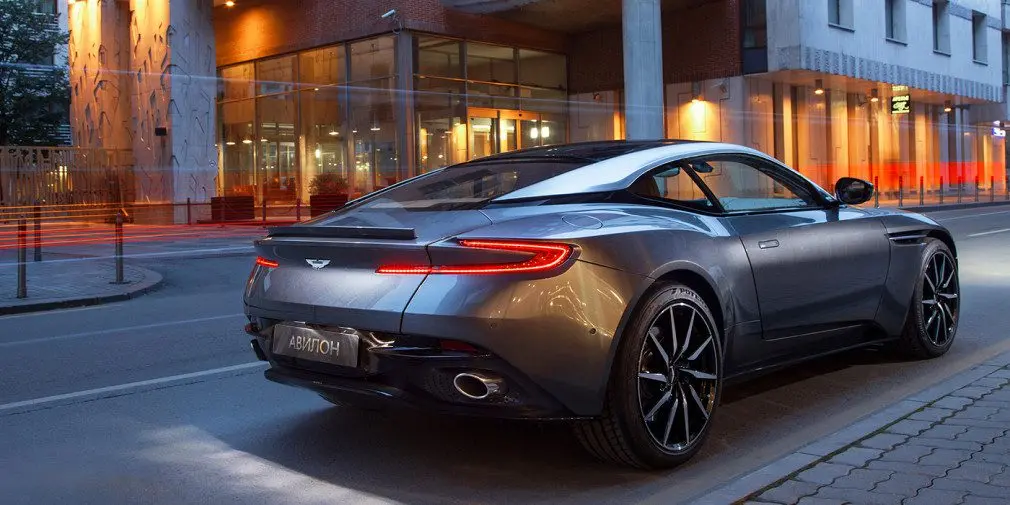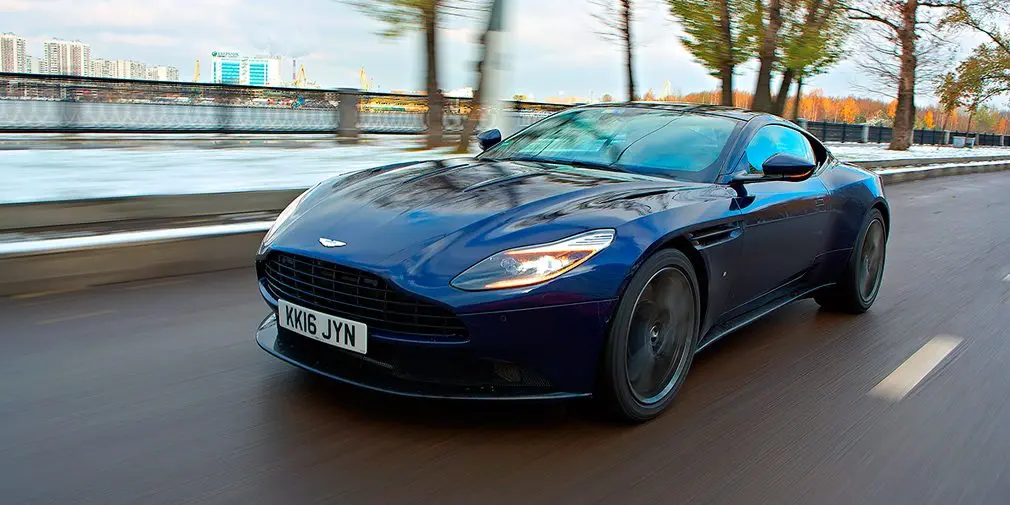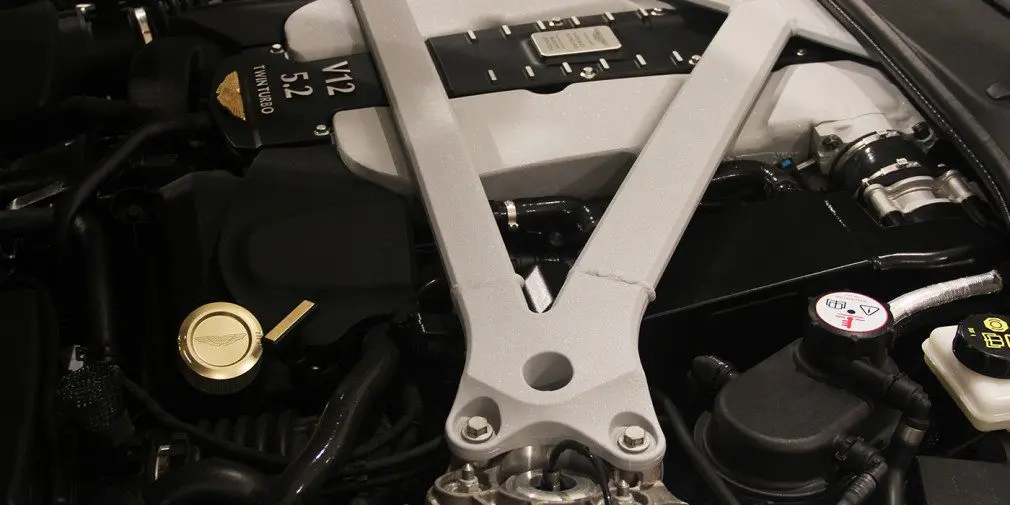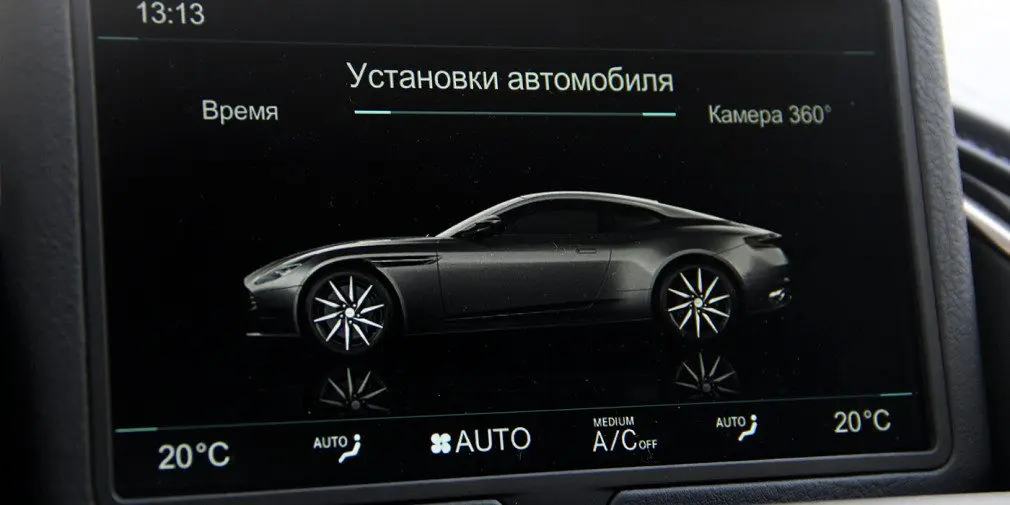
Test drive Aston Martin DB11
Heavy traffic prevented the supercar from accelerating properly, but still the DB11 drove much faster than the weather allowed. Long-nosed supercar flew over the embankment and flopped its flat bottom on the water, raising yellow spray. He slowly plunged into the river with a trim on the bow, releasing small bubbles from the perforated hood. I shouldn't have decided to revise the Spectrum before getting behind the wheel of the new Aston Martin DB11 - early winter in Moscow is not at all suitable for a 600-horsepower rear-wheel drive supercar. How not to repeat a scene from the film somewhere on Danilovskaya embankment.
James Bond's Aston Martin DB10 had a bright but short life. But is it worth the pity - the design, despite the bold lines, left a feeling of incompleteness, the platform and the V8 engine he borrowed from the simplest model Vantage, launched in the series 12 years ago. After himself, he left a spectacular flight and a pass in the model range: after the serial DB9, the DB11 immediately follows. The pass turns into a chasm in terms of evolution - the new Aston Martin has gone too far from its predecessor - this is the first model of a new era for the British company. There is not a single common detail between these cars: a new platform, the first turbo engine in the history of Aston Martin.
The image remained recognizable, but lost its old-fashioned roundness. The new styling goes hand in hand with aerodynamics: signature gills are positioned so that swirl from the wheel arches exits through them and presses the front axle at high speeds. The legs of the mirrors are associated with the plumage of the aircraft and are also an aerodynamic element. Aesthetically shaped waistline directs airflow towards the air intakes in the C-pillars. Air flows between the pillar and the glass and escapes vertically upwards through a narrow slot-sieve in the trunk lid, pressing the rear axle to the road. At speeds above 90 km / h, a stream flowing around the roof joins it - it is redirected by a special retractable spoiler. This made it possible to make the stern line sloping and dispense with bulky rear wings.

In terms of the distance between the axles, the DB11 is second only to the four-door Rapid - 2805 mm, an increase in comparison with its predecessor is 65 mm. That would be enough for a roomy mid-size sedan or crossover, but the Aston Martin coupe is built according to different laws. To achieve a weight distribution close to ideal, the 12-cylinder engine was pushed as far as possible into the base, which caused the DB11 to lose its glovebox, and the 8-speed automatic was moved to the rear axle - the so-called transaxle scheme. Wide sills and a massive central tunnel are elements of the body's power structure and eat up a lot of space in the cabin. The back two seats are still for beauty, only a child can be seated there. But the front is roomy enough, even for a corpulent driver. “Previously, another big customer who decided to try on an Aston Martin had to be retrieved with outside help,” recalls the salon manager. The trunk, although limited in volume by the transmission, can accommodate four bags, what I took for a hatch for long items turned out to be a subwoofer cover. However, the limit of desires of the owner of Aston Martin is the length of the bag with golf clubs.

The interior turned out to be somewhat eclectic: chairs from an alien ship and a virtual dashboard are adjacent to the convex center console, which is classic for Aston Martin, and thin sun visors from the middle of the last century. "Small things" from mass-produced cars in a supercar is a common story: earlier one could find ignition keys, air ducts and buttons from Volvo on Aston Martin - both companies were part of the Ford empire. Now the British manufacturer is collaborating with Daimler, so the DB11 also received a Mercedes multimedia system with characteristic graphics and a massive Comand controller. The steering column levers in the German style are located here only on the left. The few climate control keys are also quite recognizable - multimedia and climate control is mainly carried out by a touch panel with good sensitivity. The virtual tidy with a round section in the center is very similar to the Volvo one, and the origin of the round handles on the air ducts is completely obscure: you cannot immediately determine whether they were borrowed from the Mercedes-Benz S-Class or Volvo S90. Whatever the suppliers, the interior of the new coupe looks expensive and of high quality: the seams of the leather upholstery have become smoother, but their number still testifies to the abundance of painstaking manual labor.
On display in the showroom, the giant bonnet is the largest single piece of aluminum in the automotive industry. It opens with cables, but the composite trunk lid doesn't want to slam shut, and the chrome trim along the roofline flutters under your fingers. British tradition of quality? “Exhibition copy,” the director of the dealership makes a helpless gesture and asks to wait with judgments. Test machines are made in an example of better quality, although they appear in the form of pre-production ones. Six months passed from the premiere of the DB11 in Geneva to the start of mass production of the new model, and Aston Martin spent this time fine-tuning the car.

Cooperation with Daimler primarily concerns German V8 turbo engines, which will receive new Aston Martin models in the future. The British created the power unit for the DB11 with two turbines on their own and completely managed it on their own. 5,2 hp were removed from a volume of 608 liters. and 700 Nm, and peak thrust is already available from 1500 and up to 5000 crankshaft revolutions. A new unit is being produced at the same Ford plant where atmospheric engines are.
DB11 is the most powerful model of Aston Martin produced and the most dynamic - the coupe accelerates to 100 km / h in 3,9 seconds, the maximum speed reaches 322 km per hour. There are cars that are much more dynamic, but for the Gran Turismo class, which includes a large coupe weighing under two tons, this is an outstanding result.

Arranging a test drive of a heavy-duty rear-wheel drive car in November looked like a gamble. Aston Martin models are a seasonal product, and official dealers are hinting at this, offering such a service as storing the car in the cold season - for $ 1. Only the DB298 does not agree with this setting and as if nothing had happened, it accelerates along the ice-covered highway. The wide wheels slip, but the car keeps its course with confidence, without trying to skid. The lightning speed with which the speedometer counts the first hundred and approaches the second is impressive. Heavy traffic is hindering the acceleration, but the DB11 still drives faster than the weather conditions allow. The turbo engine "sings" beautifully, brightly, but it is far from the bubbling and shooting fury of Aston's aspirated people. In addition, the cabin has good soundproofing. In GT mode, the coupe strives to behave as intelligently as possible and even disables half the cylinders in the city to save gas. The automatic is much smoother and more predictable than previous single-clutch robotic transmissions. Sharp character traits show through even in comfortable mode: the steering wheel is heavy, and the brakes grab unexpectedly hard, forcing the passenger to nod his head.
In addition to controlling the transmission with round buttons on the console, you will have to get used to the mode keys on the steering wheel: the left one chooses three options for the stiffness of the shock absorbers, the right one is in charge of the transmission and steering engine settings. To switch from "comfort" mode to "sport" or to Sport +, the button must be pressed and held, and the reaction of the car is a fraction of a second ahead of the indication on the dashboard. This algorithm prevents accidental switching - a well-founded decision. Moreover, when turning the steering wheel, I accidentally touched the volume cylinder on the steering wheel several times and the music stalled.
The suspension in comfort mode handles the broken asphalt well, but does not become extremely stiff even in the Sport + position. A long press on the right key - and the engine responds to the accelerator pedal without hesitation, another press - and the box holds the gears until the cutoff, and a jerk when switching to a step down breaks the rear axle into slip. The stabilization system loosens its grip but stays alert. If you dig into the menu, you can move it to the "track" mode or turn it off altogether. Having caught the axle that had gone into a skid, I realized why this function was “buried” so deeply and hurried to turn on the safety electronics back.

On the road, the DB11 does not make a splash. This is a car that is bought exclusively for themselves, since the possibility of individualization allows you to make a unique option. Aston Martin is an engineering masterpiece and the best way to boast about it is to throw back the giant hood, which reveals a third of the car at once, and demonstrate a powerful block, suspension arrangement, stretching of the power frame. At the same time, it is quite versatile, well-tuned and does not give the impression of a small-scale "homemade" product. It is now the best Aston Martin in terms of power, dynamics and technology.
The company is betting on this particular model, located between the most affordable Vantage model and the flagship Vanquish. It will allow to melt the ice that has fettered the Russian sales of the brand in the past few years. Aston Martin even went along and reduced the price of the car for Russia: DB11 costs at least $196, which is less than in Europe. Due to the options, this price easily rises to $591 - the test cars cost so much. Moreover, they had to be additionally equipped with ERA-GLONASS devices, and the cars will have to undergo expensive certification with crash tests according to the new rules. Of course, all this is not in vain - according to the operating director of the Luxury Automotive division of Avilon Vagif Bikulov, the required number of pre-orders has already been collected and negotiations are underway with the plant to expand the Russian quota. Vehicle production for Russia will start in April, and the first customers will receive the DB222 in early summer.
| Aston Martin DB11 | ||
| Body type | Coupe | |
| Dimensions (length / width / height), mm | 4739/1940/1279 | |
| Wheelbase, mm | 2805 | |
| Ground clearance, mm | No data | |
| Cargo space | 270 | |
| Curb weight, kg | 1770 | |
| Gross vehicle weight, kg | No data | |
| engine's type | Turbocharged petrol V12 | |
| Working volume, cubic meters cm. | 3998 | |
| Max. power, h.p. (at rpm) | 608/6500 | |
| Max. cool. moment, nm (at rpm) | 700/1500-5000 | |
| Drive type, transmission | Rear, AKP8 | |
| Max. speed km / h | 322 | |
| Acceleration from 0 to 100 km / h, s | 3,9 | |
| Average fuel consumption, l / 100 km | No data | |
| Price from, $. | 196 591 |

